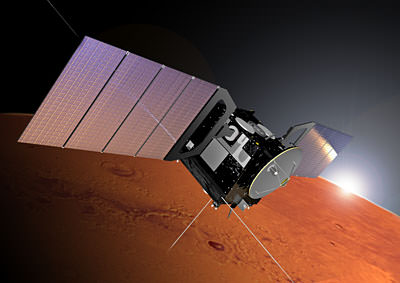[/caption]
The European Space Agency has extended operations of three missions: Mars Express, Venus Express and Cluster, until the end of the year, citing “excellent” research returns from all three missions. Each mission has been extended at least once in its history, said Monica Talevi, an ESA spokeswoman — but they’re all worth it.
“The scientific community recognizes and ESA recognizes that these missions have provided excellent results,” she said.
Mars Express
The first European mission to the Red Planet, Mars Express has been orbiting Mars since the end of 2003. Besides high-resolution color images of the Martian surface, the spacecraft has also beamed back mineralogical evidence for the presence of liquid water throughout Martian history and studied the density of the Martian crust in detail. Mars Express was the first spacecraft to detect methane in the planet’s atmosphere from orbit. Its radar instrument, the first flown to Mars, has returned pioneering sub-surface sounding measurements that show underground deposits of water ice. The mission has also pioneered insights into the Martian atmosphere, including the detection of aurorae at mid-latitudes and new estimates for the rate at which Mars’ atmosphere escapes into space.
The mission has been extended twice in the past, with the most recent lasting until May 2009. This third extension will make it possible to continue with the mission’s study of the Red Planet which includes, among other inquiries: the study of its subsurface, the observation of the upper atmospheric layers under varying solar conditions, observation of methane in the atmosphere and high resolution mapping of its surface.
Venus Express
Since it reached Venus in April 2006, Venus Express has been mapping Venus’s noxious and thick atmosphere globally and in 3D for the first time. With the data, scientists have put together extensive meteorological maps of Venus, providing measurements of wind fields and temperatures and the chemical composition of the atmosphere.

The spacecraft has peered at the planet’s dynamic cloud system, including its striking double-eyed atmospheric vortex that dominates the south pole. It’s found water molecules escaping into space, concrete evidence for lightning in the Venusian atmosphere, and infrared glimpses of the hot surface.
Previously extended once to last until May 2009, the next extended phase will be used to improve scientists’ understanding of how Venus’ climate works, and search for suspected active volcanism on the planet’s surface.
Cluster
The Cluster constellation was launched in summer 2000 and started operating in early 2001. Since then, the four-satellite mission has been spying on the Earth’s own magnetosphere, the magnetic bubble surrounding our planet. Its work is yeilding new insights into the way solar activity affects the near-Earth environment.

Cluster pioneered measurements of electric currents in space, revealed the nature of black aurorae, and discovered that plasma — a gas of charged particles surrounding Earth — makes ‘waves.’ The mission also provided the first 3D observation of magnetic reconnection in space — a phenomenon that reconfigures the magnetic field and releases high amounts of energy.
The Cluster mission has been extended twice in the past, up to June 2009. The new extension will make it possible to study the auroral regions above Earth’s poles and widen the investigations of the magnetosphere, particularly its inner region.
Source: ESA


nice post good to hear not everyone is giving up the space programs
Monica Talevi really got it right. Good to see that co-operation between many nations still works, and that important efforts in this regard benefits so greatly the scientific community. At last all the efforts of the last few decades are starting to pay off handsomely for the ESA, who are starting to show formidable leadership in space exploration. Other space-faring nations could learn much from their methods and resolve. Go ESA!
Yes, ESA is on track! The future is theirs!
Good article!- nice to give credit where credit is due!
Gotta say ESA is simply king of bang-for-buck for science missions. I must say that I don’t think they have a single mission set to fly that I’m not 100% engaged in and looking forward to greatly. They do a great job of putting together high-impact missions with the money they have available.